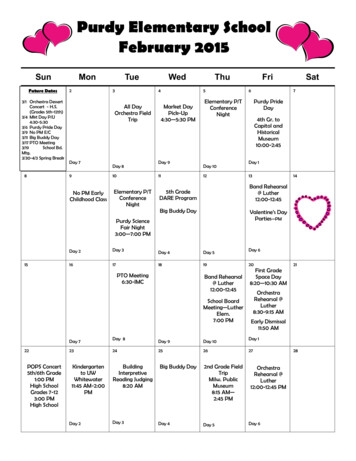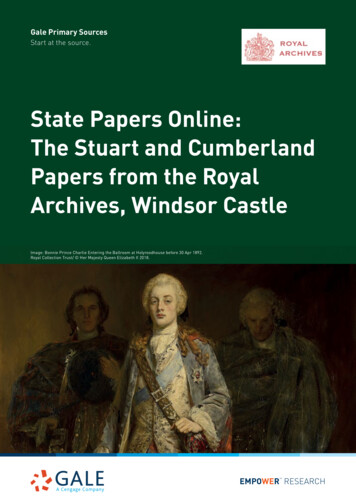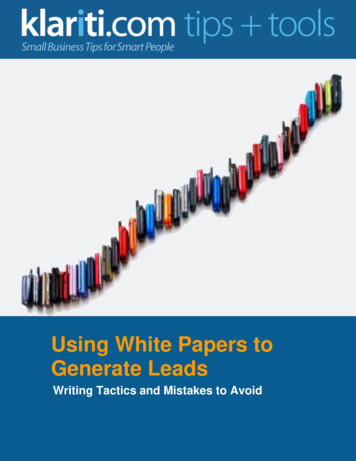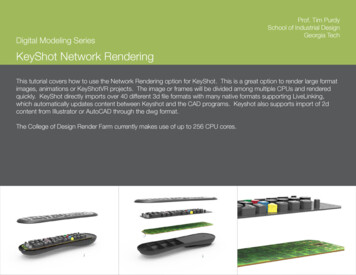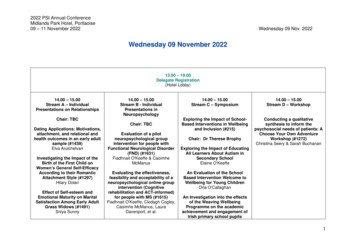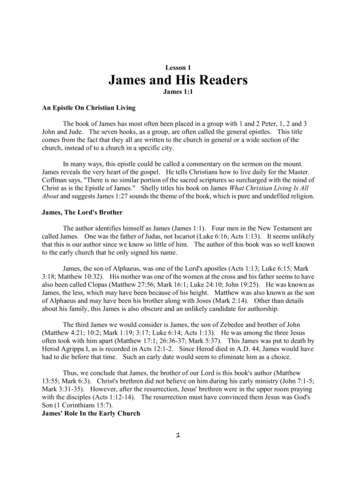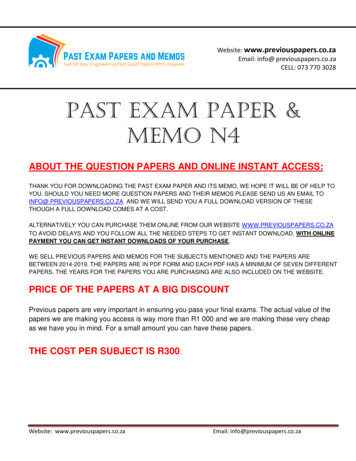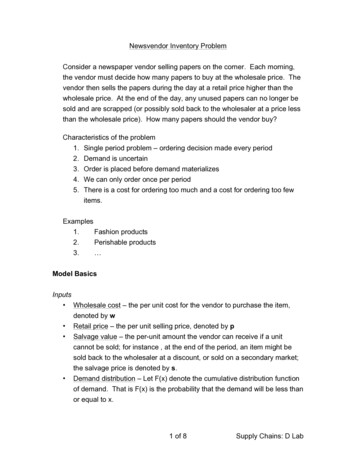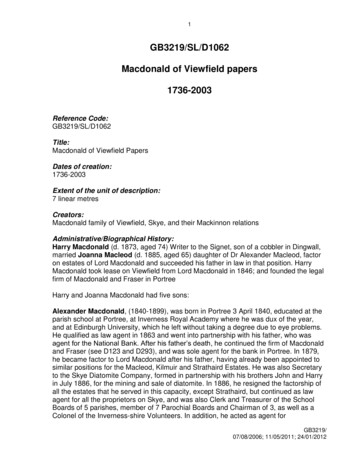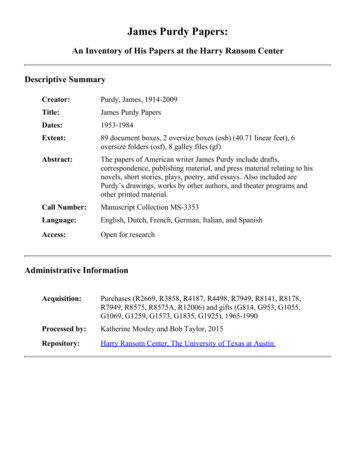
Transcription
James Purdy Papers:An Inventory of His Papers at the Harry Ransom CenterDescriptive SummaryCreator:Purdy, James, 1914-2009Title:James Purdy PapersDates:1953-1984Extent:89 document boxes, 2 oversize boxes (osb) (40.71 linear feet), 6oversize folders (osf), 8 galley files (gf)Abstract:The papers of American writer James Purdy include drafts,correspondence, publishing material, and press material relating to hisnovels, short stories, plays, poetry, and essays. Also included arePurdy’s drawings, works by other authors, and theater programs andother printed material.Call Number:Manuscript Collection MS-3353Language:English, Dutch, French, German, Italian, and SpanishAccess:Open for researchAdministrative InformationAcquisition:Purchases (R2669, R3858, R4187, R4498, R7949, R8141, R8178,R7949, R8575, R8575A, R12006) and gifts (G814, G953, G1055,G1069, G1259, G1573, G1835, G1925), 1965-1990Processed by:Katherine Mosley and Bob Taylor, 2015Repository:Harry Ransom Center, The University of Texas at Austin
Purdy, James, 1914-2009Manuscript Collection MS-3353Biographical SketchJames Otis Purdy was born in Hicksville, Ohio, on 17 July 1914 as the second of threesons of William Purdy and his wife, Vera Cowhick Otis. The family moved to Findlay,Ohio before 1920 and within the next several years James’ parents divorced. Vera Purdyand her sons continued to live in Findlay, where she operated their large residence as aboarding house.Purdy graduated from high school in the early 1930s, and afterwards attended BowlingGreen State College, graduating in 1935 with a BA degree and a teaching certificate inFrench. After moving to Chicago to further his education he met the painter GertrudeAbercrombie and before long became a member of the group of creative peopleassociated with her.Building on an early interest in reading and creative writing, Purdy’s Chicago years hadintroduced him to new cultural experiences in literature and especially jazz music, withits mostly African-American creators and performers. Before World War II, he hadbegun attempts at creative writing, publishing a single story in 1939, but the war yearswere largely unproductive for him.In 1941, Purdy enlisted in the U.S. Army, where he continued to develop his foreignlanguage skills, eventually working as an interpreter and teaching school in Havana,Cuba for a time. Shortly after the end of the war, Purdy secured a position at LawrenceCollege in Appleton, Wisconsin, where he taught Spanish from 1947 to 1956.It was only in 1946 that Purdy was able to place a story, "You Reach for Your Hat," inThe Prairie Schooner. He settled in Appleton and was able for the first time in his life toset aside blocks of time for writing. Even with the production of a significant number ofstories Purdy found acceptance by editors another matter: by 1955 he’d sold only onestory, "The Sound of Talking," to the Black Mountain Review.In 1956, however, Don’t Call Me by My Right Name and Other Stories and 63: DreamPalace, a Novella were privately published on Purdy’s behalf, the former by OsbornAndreas, a Chicago businessman and critic, and the latter by Purdy’s friend JormaSjoblom. Purdy sent copies of the two volumes to various writers and critics he feltmight be receptive and one of the recipients, Edith Sitwell, was so favorably impressedshe began a correspondence with Purdy and persuaded Victor Gollancz to bring out thetext of the two privately-published volumes as 63: Dream Palace: A Novella and NineStories.The positive response to the Gollancz edition was sufficient to convince Purdy to leaveteaching and become a full-time writer. He moved to New York City in 1958 and a yearlater began his long-term residence in the apartment at 236 Henry Street in Brooklyn.The five years following Purdy’s emergence as a published writer found him productiveand enjoying growing critical esteem and commercial success. 1959 saw the appearanceof his first full-length novel Malcolm, an early take on the uncertain path of aCandide-like innocent in an unpredictable and perverse world. Dorothy Parker praisedMalcolm lavishly, and Albee adapted it for the stage. Purdy followed Malcolm with2
Purdy, James, 1914-2009Manuscript Collection MS-3353another novel, The Nephew (1960), and a collection of stories, Children Is All (1961).Paralleling Purdy’s generally well-received writing was his success in garnering grantsto support his work. The National Institute of Arts and Letters and the GuggenheimFoundation awarded him grants in 1958, followed by a Ford Foundation grant in 1961and another Guggenheim in 1962.From the appearance of Cabot Wright Begins (1964) Purdy began to leave much of hispotential readership behind as his dark satire became increasingly bold. Cabot Wrightwas reviewed with approval by Susan Sontag for the New York Times, but the novel’sprotagonist, a serial rapist, was a challenge for many potential readers. His next novel,Eustace Chisholm and the Works (1967), was polarizing with its sadomasochisticelements but, even so, failed both as a conventional success and as a succès de scandale.With the failure in the marketplace of Eustace Chisholm Purdy terminated hisrelationship with Farrar, Straus, and Giroux, publisher of all his novels to that point. Hewas by now provoked with what he saw as a monolithic New York intellectual andcultural community opposed to him and his work, and, apart from his personal respect forRobert Giroux he found the firm lacked any interest in him or his work.Jeremy’s Version (1970) was the first part of the tetralogy Sleepers in Moon-crownedValleys and the first of his novels to be published by Doubleday, followed in 1972 by Iam Elijah Thrush and The House of the Solitary Maggot (1974), the second volume ofthe tetralogy. The reception of these works was not strong, and Purdy’s attitude towardDoubleday soon soured, leading him to publish In a Shallow Grave (1975) and NarrowRooms (1978) with Arbor House.Continuing general critical and popular indifference to his fiction made James Purdyseem ever more a "writer’s writer," appealing in general to a small audience of acolytesand receptive critics. There were from time to time, however, voices raised on behalf ofhis highly individual style and subject matter. Tennessee Williams praised hisrarely-performed plays, and Gore Vidal found Narrow Rooms"a dark and splendid affairby an authentic American genius."In the early 1980s, Purdy completed the Sleepers tetralogy with Mourners Below (1981)and On Glory’s Course (1984), both published by Viking Press. In 1982, the UnitedStates Information Agency sponsored a lecture tour to Europe and Israel, enabling Purdyto continue his practice of appearances before younger audiences in colleges and othereducational venues.Purdy continued to write throughout the 1980s and 1990s with little reaction from thecritical community or potential readers, but as the twenty-first century began, the literaryopinion of Purdy experienced a modest uptick. In 2005, author Jonathan Franzenpresented him the Mercantile Library’s Clifton Fadiman Award for Eustace Chisholm,and later in the year Gore Vidal wrote a striking appreciation of his writing in The NewYork Times Book Review.In 1996, Gertrude of Stony Island Avenue, Purdy’s last novel published in his lifetimeappeared, followed four years later by Moe’s Villa and Other Stories. James Purdycontinued to live and write at 236 Henry Street until moving to a nursing home inEnglewood, New Jersey not long before his death, which occurred on 13 March 2009.3
Purdy, James, 1914-2009Manuscript Collection MS-3353Sources:Dahlin, Robert. "James Purdy" [interview], Publishers Weekly, 19 June 1981Evenson, Brian. "James Purdy," Dictionary of Literary Biography, v. 218, 1999French, Warren, and Donald Pease. "James Purdy," Dictionary of Literary Biography,v. 2, 1978Grimes, William. "James Purdy, a Literary Outsider with a Piercing Vision, is Dead at94," New York Times Reprints tree, Christopher. "James Purdy," The Guardian, 15 March urdy-obituary]"James Purdy," Contemporary Authors Online [http://galenet.galegroup.com/]Morrow, Bradford. "An Interview with James Purdy," Conjunctions, Fall e and ContentsThe James Purdy papers represent the years 1953 through 1984 and include manuscripts,correspondence, photographs, art works, proofs, journals, clippings, and printed materialbelonging to the American writer James Purdy (1914-2009). The professional andpersonal papers document Purdy’s evolution as a writer of novels, short stories, poetry,and plays. The papers are organized in four series: I. Works by Purdy, 1955-1984,undated; II. Correspondence, 1953-1984; III. Personal and Career-Related Material,1958-1984; and IV. Works by Others, 1958-1984. A portion of this collection (boxes1-25) was previously accessible through a card catalog, but is now described in thisfinding aid along with materials received in later accessions. During rehousing of thematerials, Purdy’s labeled file folders were retained when they contain additional notesin his hand. His file titles are indicated in the finding aid’s container list by singlequotation marks.Series I. Works is comprised primarily of notebooks, drafts, proofs, and other materialsrelated to Purdy’s novels, short stories, plays, and essays. These materials date from1955 to 1984, and are arranged alphabetically by title. Also included are Purdy’sanonymous hoax letters, artwork, autobiographical statements, blurbs for works by otherwriters, poetry, satirical sketches of literary critics and figures, and statements or essayson various topics written for publications.Of particular interest are notebooks containing drafts for Purdy’s plays Madonna and4
Purdy, James, 1914-2009Manuscript Collection MS-3353Of particular interest are notebooks containing drafts for Purdy’s plays Madonna andWedding Finger and his novels Cabot Wright Begins, Jeremy’s Version, EustaceChisholm and the Works, The House of the Solitary Maggot, I Am Elijah Thrush, In aShallow Grave, Malcolm, Narrow Rooms, and The Nephew. Also present in thenotebooks are draft fragments of other plays, poems, and short stories; story ideas; notes;quotations; doodles; publication information on stories; financial notes; and appointmentand contact information.Purdy often sent what he called anonymous and anomalous letters to friends and otherrecipients. These creative pieces included hoax news stories or press releases, satiricaladvertisements, and letters sent anonymously or purporting to be from someone else.Most of these are located together in the papers as Anonymous/Anomalous Letters, butbecause Purdy sometimes sent drafts of the letters to confederates in other locations whowould then type and mail the letters to the intended recipients, a few are located in hispersonal correspondence. Among the nicknames given to friends in these mock lettersare Adonis Whiteacre (Douglas Turnbaugh), Anthony of London (Anthony Harvey),Babe Helps (Robert Helps), and Baby B (Richard Hundley).Under the heading of Artwork are drawings by Purdy, including a sketchbook and loosesketches for The Running Sun.Purdy’s poetry is filed together and arranged by title of individual poem or group ofpoems. Some poems, such as "The Sea Is Swimming Tonight" and "Straightway Beautyon Me Waits," were set to music by composer Richard Hundley. Robert Helps alsocomposed music for poems by Purdy, most notably from Purdy’s collection TheRunning Sun (1971); typescript and handwritten poems, a typesetting copy, artwork, andprinter’s paste-ups for The Running Sun are present. Other early versions of poems fromthat work are located elsewhere in the poetry files; for example, several poems of agroup dating from 1971 were later revised and included in The Running Sun. Ofparticular note is an undated hand-bound book of typescript poems and drawings byPurdy. A drawing also accompanies a group of handwritten poems dating from 1970 to1976.Among unidentified or untitled works are several statements or essays by Purdyregarding his own work, literary success, George Orwell’s Nineteen Eighty-four, theVietnam War, and other topics, intended for publication in various periodicals. Alsopresent are handwritten notes and a typescript of an article for LIFE about EdwardAlbee’s dramatization of Malcolm. While composing his novels, Purdy wouldsometimes employ a stream-of-consciousness method of typing or writing a few pages toaid his thought processes. Although a few of these are found among drafts for particularworks, most of these "driftings" or practice writing pages are located with unidentifiedtypescript fragments at the end of the Works series. One such fragment (folder 3.5)contains a note that it is "gibberish but the books come out of it."Series II. Correspondence represents the years 1953 to 1984 and runs to nearly 48 boxes.Most of this material is related directly to Purdy’s career as a writer and representscorrespondence with publishers, editors, literary agents, scholars, writers, and fans.While there is little material here of a fundamentally biographical or personal nature,there are letters from friends dating from his years in Chicago and Appleton, Wisconsin,and even some with family or other Ohio ties.5
Purdy, James, 1914-2009Manuscript Collection MS-3353Among the people Purdy knew from his time in Chicago or Appleton who arerepresented by a significant correspondence are Gertrude Abercrombie, Miriam Andreas,Hastings Brubaker, Jeannette Druce, Norman MacLeish, Jorma Sjoblom, and SamuelSteward. Critics, book people, and literary scholars like Len Berkman, Frank Daniel,Donald Gallup, Gordon Lish, Irving Malin, and Bettina Schwarzschild appear here, asdo the writers Stephen D. Adams, Paul Bowles, Gerald Brenan, Paula Fox, and James L.White.Purdy’s relationships with publishers were often strained and his correspondencepresented here with Doubleday, Esquire, Farrar, Straus, and Giroux, and New DirectionsPublishing sometimes bears this out. These strains, as well as his generalized antagonismtoward the New York critical community, are documented primarily as passing (but notuncommon) references in his own outgoing correspondence with friends and fellowwriters.Copies and drafts of Purdy’s outgoing correspondence for the period 1953 to 1972 arefiled as Subseries A. For the years 1972 to 1984 outgoing correspondence is interfiledwith the recipient in Subseries B where possible; otherwise they are found in SubseriesA. There is also a significant amount of third-party correspondence. Such letters for theyears 1953 to 1972 are present as Subseries C. For the years 1972 to 1984 third-party isinterfiled with either Subseries A or B if originally found with correspondence filed inthose series, but otherwise it will be in Subseries C. Correspondence from throughout thecollection is listed in the Index of Correspondents at the end of this finding aid.Series III. Personal and Career-Related Material is a variegated group comprisingautobiographical statements; catalogs and brochures; clippings; daybook and calendarpages; financial material; flyers; printed invitations, advertising cards, and pamphlets;menus; notes and jottings; periodicals; programs and ticket stubs; material related toreadings and lectures by Purdy; review clippings and advertisements; small presskeepsakes; snapshots; and unused postcards and greeting cards, all dating from 1958 to1984. Similar items received with early accessions were separated from the papers atthat time and transferred to the Center’s Vertical File Collection.Catalogs and brochures include those relating to art exhibitions, bookseller andmanuscript dealers, housewares, and publishers. Among artists represented by exhibitioncatalogs are Alice Pike Barney, Clarence H. Carter, Gloria Vanderbilt, and CliffordWright. Images of Edith: An Exhibition of Portraits of Dame Edith Sitwell (1977)includes a foreword by Sacheverell Sitwell. Booksellers and manuscript dealers includeBertram Rota, Gotham Book Mart, David Schulson, Joseph the Provider, and Sylvester& Orphanos. Among publishers are Albino, Arbor House, Black Sparrow Press, VincentFitzGerald, New Directions, Plain Wrapper Press, Ram Publishing Company, VikingPress, and W. H. Allen. Purdy’s books are found in some of these catalogs.Clippings dating from 1969 to 1983 and sent to Purdy by friends and correspondentscover a variety of subjects; of note are a large group regarding artist Clifford Wright.Financial material consists of contracts, expense notebooks from 1972 to 1976, invoicesand receipts, a 1972 lease, and royalty statements from 1958 to 1983. Invoices andreceipts range from household bills to charges for purchases from Gotham Book Mart.New York City transit tickets are also present.6
Purdy, James, 1914-2009Manuscript Collection MS-3353The numerous pages of Purdy’s notes and jottings present here include those with namesand contact information for various individuals or organizations, as well as lists ofplants, grocery lists, quotations, and other subjects. These date from 1969 to 1984 andare arranged by year. In addition, a notebook dating from 1972 to 1974 contains notes onplants, art, and sculpture.Whole issues of periodicals include Angwamas Minosewag Anishinabeg (Time of theIndian), Atticus Review, Audit/fiction (Anne Pitrone From The Recession Diary), bits,Bright Lights, Clandestine America, Coda: Poets & Writers Newsletter, Contact II, EastRiver Review, Footnotes*, Kick, Lunch, The Morning Star People, Music Journal,Nuovi Argomenti, Paris Review, Le Promeneur, Sequoia, Sparrow, and Toucan.Printed invitations, flyers, advertising cards, and pamphlets date from 1971 to 1984 andare arranged by year. Most of these relate to art exhibitions, readings, performances, andsimilar events. Those bearing handwritten notes to Purdy have been moved to thecorrespondence files and are included in the Index of Correspondents.Programs and ticket stubs document attendance at film screenings; opera and othermusic performances; and theater and dance productions. Within those categories,arrangement is by year. Of note among film screening programs are those for VirgilThomson Composer (1980) and You Are Not I: A Film by Sara Driver, A Story by PaulBowles (1983).Music programs relate to performances Purdy attended as well as those connected to hiswork. Venues include Carnegie Recital Hall, Fifth Avenue Presbyterian Church, theKitchen Center, Lincoln Center, the Montauk Club, the 92nd Street Y, the VillagePresbyterian Church, and others. Many of the Purdy-related music performancesfeatured his poems set to music by Robert Helps and Richard Hundley; among these areHelps’s music for five poems from The Running Sun and Hundley’s songs for "Birds,U.S.A.,""Come Ready and See Me,""Evening Hours,""I Do,""Jenny Wren," and "OverGreen Leaves." Joseph Fennimore’s opera Eventide, based on the short story by Purdy,was performed at The After Dinner Opera Company in New York.Of note among theater and dance programs are those for the 1979 New York premiere ofTennessee Williams’ A Lovely Sunday for Creve Coeur at the Hudson Guild Theater, the1972 premiere of Williams’ Small Craft Warnings at the Truck and Warehouse Theatre,and the 1980 Harold Clurman Theatre production of Williams’ The Two-CharacterPlay. Other playwrights represented include Edward Albee, Edward Gallardo, HenrikIbsen, William Inge, Paul Stephen Lim, William Mastrosimone, Maxim Mazumdar,Leonard Melfi, Poty Oliveira, Luigi Pirandello, David Rabe, Gus Weill, and RomainWeingarten. In addition, there are programs from a WPA Theatre production of UncleTom’s Cabin and several Shakespeare productions. Programs for Aegis Universal Danceand Performance Group, the National Youth Theatre of Great Britain, and the PaulineKoner Dance Consort are also present. Annotations by Purdy on some programs recordhis opinion of the performance, with whom he attended, or information about actors.Also documented here are plays written by Purdy or adapted by others from his work.Edward Albee directed his adaptation of Purdy’s novel Malcolm at SouthwesternUniversity in 1983, and a program from that production is present, as are a contact sheetand prop list for How I Became a Shadow and a flyer advertising the premiere of True.Materials relating to the HB Playwrights Foundation 1979 production Out of a Clear7
Purdy, James, 1914-2009Manuscript Collection MS-3353Blue Sky (the one-act plays What Is It, Zach? , Now, Adeline, and Wonderful HappyDays) include a flyer, program, Purdy’s typed biographical information, and hishandwritten notes on the musical accompaniment. The Iowa Theater Lab producedseveral of Purdy’s plays, and their newsletters, a Stories of Darkness program, and ahandout for Proud Flesh are present. Programs from the Ensemble Studio Theatre’sproduction of Daddy Wolf and a postcard advertisement of Nightshift’s presentation ofTrue, The Berry Picker, and What Is It, Zach? complete this group.Readings, lectures, and appearances by Purdy between the years 1971 and 1984 arerepresented by flyers, press releases, clippings, and programs. Also found here areitineraries from Purdy’s participation in the University of Notre Dame Literary Festivaland his international lecture tour sponsored by the International Communication Agencyin 1982.Review clippings of Purdy’s books are arranged alphabetically by title and encompassthe years 1964 to 1982. Reviews of stage adaptations of Eustace Chisholm and theWorks and The Nephew accompany reviews of the novels, and a large group of Germanpress clippings regarding The Nephew are also present. A Dutch review of 63: DreamPalace by Jan Siebelink was published in Hollands Maandblad. An article,advertisement, and interview with Ric Zank relate to the Iowa Theatre Lab’s productionof three of Purdy’s plays as Proud Flesh in 1981.Keepsakes and printed greeting cards were sent to Purdy by small presses such asBellevue Press, Cadmus Press, New Directions, Phoenix Bookshop, Plain WrapperPress, and Red Ozier Press. These printed items include poems by Federico GarcíaLorca, Bradford Morrow, Kenneth Rexroth, and Gil Williams, as well as artwork byFiske Boyd, Allen Lewis, and Lynd Ward. Copies of "Tea with Alice [Toklas]" and"Mushrooms," both by Robert A. Wilson, are present. "A Christmas Recipe," written byAnthony Burgess and illustrated by Fulvio Testa, was printed by Plain Wrapper Press asa holiday greeting in 1977. A New Year’s greeting from Red Ozier Press in 1983 waswritten by Edouard Roditi.A small number of snapshots of various individuals that were sent to Purdy by friendsand correspondents but separated from the correspondence are grouped together by year.Series IV. Works by Others contains materials created by writers and artists other thanPurdy and is divided into two subseries: A. Works about Purdy and His Writing,1952-1982, and Subseries B. Other Works, 1958-1984. Both subseries are arrangedalphabetically by author. Among notable manuscripts on Purdy and his work are thoseby Stephen Adams, Warren French, Donald Pease, Bettina Schwarzschild, and JosephSkerrett. A typescript blurb by Paul Bowles for Purdy’s novel Jeremy’s Version, atypescript review of Malcolm by Dorothy Parker, and Edith Sitwell’s typescript prefaceto Purdy’s Colour of Darkness are also present. Robin Gaither, a former student whohad extensive correspondence with Purdy from 1979 to 1980, sent him her typescript ofAn Editing Project: The Purdy-Gaither Letters.Articles about and interviews with Purdy, as well as bibliographies of his work, are alsoincluded in this subseries. Among the interviews are a copy of Jan Siebelink’s "JamesPurdy" published in HP in 1981 and typescripts by Charles Stetler and Gerald Locklin(1980) and Stephen Varble (1972).8
Purdy, James, 1914-2009Manuscript Collection MS-3353Subseries B. Other Works comprises manuscripts, printed broadsides, tearsheets,offprints, proofs, artwork, and similar material by Purdy’s friends, colleagues, andothers. Edward Albee’s stage adaptation of Purdy’s novel Malcolm is represented by a1965 typescript containing extensive notes and comments by Purdy. A typescript ofRichard Ede’s teleplay adaptation of Purdy’s Colour of Darkness dates from 1968. Pageproofs of Three Tales (1975) by Paul Bowles and poems handwritten by Edith Sitwell in1958 titled "The Death of a Giant" and "The Outcasts" are of special interest. A printedinsert from the sound recording Façade, a reading by Sitwell of her poems to music byWilliam Walton, includes the text of the poems. Drawings made by Ian Campbell forThe Running Sun in 1971 are included in the series, as is artwork by Donald Gosaynie,Steven Osterlund, and Mylo Quam. Also noteworthy are two duplicated handwrittensong scores of Richard Hundley’s music setting for Purdy’s poem "Come Ready and SeeMe."Related MaterialFor additional materials related to James Purdy at the Harry Ransom Center, seemanuscript holdings for Jane Auer Bowles, Paul Bowles, Gerald Brenan, Ronald Christ,E. E. Cummings, Genesis West, Gotham Book Mart, Peter Owen Ltd., Derek Parker,Edith Sitwell, and Lee Smith.Other institutions with James Purdy materials include the Beinecke Rare Book andManuscript Library, Ohio State University, the University of Delaware Library,University of Georgia Hargrett Rare Book and Manuscript Library (including the FrankDaniel Papers), and the University of Rochester.Separated MaterialCopies of Purdy’s published works and other bound volumes were transferred to theRansom Center Library.Portraits of Purdy and various people by Carl Van Vechten and other photographers, aswell as stills from Fortune and Men’s Eyes and Color of Darkness, were transferred tothe Ransom Center’s Photography Collection.Ink drawings by Purdy and paintings by Steven Osterlund dating from 1961 to 1970were transferred to the Ransom Center’s Art Collection.A record needle stylus, bird wing, and Star Explorer chart were transferred to theRansom Center’s Personal Effects Collection.Various publications, clippings, publicity material, invitations, programs, and other9
Purdy, James, 1914-2009Manuscript Collection MS-3353Various publications, clippings, publicity material, invitations, programs, and otherminor printed matter received with early accessions of Purdy manuscripts weretransferred to the Ransom Center Vertical Files Collection. However, similar materialsfrom later accessions are cataloged with his papers and described in the Container List ofthis finding aid.Index TermsPeopleAbercrombie, Gertrude, 1909-1977.Berkman, Len.Bowles, Paul, 1910-1999.Brenan, Gerald.Daniel, Frank, 1900-1981.Fox, Paula.French, Warren.Helps, Robert.Lish, Gordon.Malin, Irving.Schwarzschild, Bettina.Sjoblom, Jorma Jules.Steward, Samuel M.Yellin, Herb.OrganizationsDoubleday & Company, Inc.Farrar, Straus, and Giroux.New Directions Publishing Corp.Viking Press.SubjectsAuthors, American--20th century.Dramatists, American--20th century.Novelists, American--20th century.Poets, American--20th century.Document Types10
Purdy, James, 1914-2009Manuscript Collection MS-3353Document TypesBroadsides.Cartoons (humorous images).Christmas cards.Drawings.First drafts.Galley t music.11
Purdy, James, 1914-2009Manuscript Collection MS-3353Series I. Works by Purdy, 1955-1984, undatedAnonymous/anomalous letters and mock press releases and articles1963Container 26.11967-1970Container 3.8, 4.1, 36.51971-1972Container 26.21973Container 26.31974Container 26.41975Container 26.5Container 26.6-7, 41.2,61.51976-19781981Container 26.8UndatedContainer 26.9Container26.10The Anonymous/Anomalous Letters of Passion, typescript, undatedArtworkContainer26.11-12Artist’s sketchbook and loose drawings for The Running Sun, 1971Drawings, undatedContainer 23.9Drawing, 1973Container 26.13Sketchbook, printed text in whole issue of Mediums 1982: Writers DrawContainer26.14Autobiographical statements. Handwritten and typescript drafts, undatedContainer1.3Blurbs for works by Raymond Kennedy, Will Perry, and John Ratti, 1974, undatedContainer1.3, 26.15Brawith (short story). Typescript fragment, undatedContainer26.16Cabot Wright Begins (novel)12
Purdy, James, 1914-2009Manuscript Collection MS-3353Notebook vol. 1, 1961-1962Container 26.17Container26.18Notebook vol. 2, also containing play Last Hot Meal of Tecmessa Starr, 1963‘Scraps from early versions,’ August-October 1963Container 1.3,26.19‘Early notes,’ ‘Esquire version,’ typescript fragments with revisions, undatedContainer27.1‘Original typescript’ incomplete typescript with revisions, August 1962, May1963-January 1964Container27.2-3‘Carbon copy with author’s corrections of final typescript,’ undatedContainer27.4-5‘Xerox copy,’ typescript with revisions, undatedIncomplete page proofs (only pages with edits), undatedContainer 27.6,28.1Container 1.3Camilo Gomez and Mr. Hing (short story). Typescript and handwritten fragments;typescript titled April Again with revisions, undatedChildren Is All (play)‘Discarded version,’ typescript (two copies, one missing p. 1), undatedContainer28.2‘Completed revised play,’ typescript with revisions, undatedContainer1.5‘Working copy,’ ‘Revised Version,’ typescript (two copies with slightly variantrevisions), 20 February 1962Container1.5, 28.3Typescript (two copies), undatedContainer 28.4Children Is All (collected stories and plays)Typesetting copy, composite typescript and printed text, 1962Page proofs of plays Children Is All and Cracks, undatedThe Christian Vision in My Work (essay). Typescript (two copies), undated13Container1.4Container gf1Container1.3, 28.5
Purdy, James, 1914-2009Manuscript Collection MS-3353Color of Darkness and Malcolm (short story collection and novel)Introduction to James Purdy’s Color of Darkness and Malcolm. Two typescr
Purdy graduated from high school in the early 1930s, and afterwards attended Bowling Green State College, graduating in 1935 with a BA degree and a teaching certificate in French. After moving to Chicago to further his education he met the painter Gertrude Abercrombie and before long became a member of the group of creative people associated .
